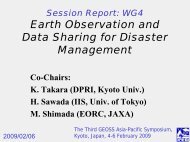Efforts in Tropical Storm Modeling, Prediction and Projection
Efforts in Tropical Storm Modeling, Prediction and Projection
Efforts in Tropical Storm Modeling, Prediction and Projection
Create successful ePaper yourself
Turn your PDF publications into a flip-book with our unique Google optimized e-Paper software.
<strong>Efforts</strong> <strong>in</strong> <strong>Tropical</strong><br />
Image: NASA.<br />
<strong>Storm</strong> Model<strong>in</strong>g,<br />
<strong>Prediction</strong> <strong>and</strong><br />
<strong>Projection</strong><br />
G.A. Vecchi 1 , M. Bender 1 , J.H.<br />
Chen 1 ,<br />
T. Delworth 1 , Y. Fan 1 , I.M. Held 1 ,<br />
H.S. Kim 2 , T.R. Knutson 1 , S.J. L<strong>in</strong> 1 ,<br />
R. Msadek 1 , A. Rosati 1 , G.<br />
Villar<strong>in</strong>i 2,3 ,<br />
M. Zhao 1<br />
1.NOAA/GFDL, Pr<strong>in</strong>ceton, NJ<br />
2.Willis Research Network<br />
3.Pr<strong>in</strong>ceton U., Dept. Civil Eng<strong>in</strong>eer<br />
Gabriel.A.Vecchi@noaa.gov<br />
Presentation at “Climate 2012”
Data Homogenization for North Atlantic Hurricanes<br />
Adjustments to storm<br />
counts based on<br />
ship/storm track locations<br />
<strong>and</strong> density<br />
Vecchi <strong>and</strong> Knutson (2008, J. Clim.)<br />
L<strong>and</strong>sea et al. (2009, J. Clim.)<br />
Vecchi <strong>and</strong> Knutson (2011, J. Clim.)
GFDL Hi-Res Global Models<br />
In order to represent processes <strong>and</strong> phenomena, GFDL<br />
has been develop<strong>in</strong>g high-resolution global models.
GFDL High Resolution Coupled Model<br />
Development<br />
Scientific Goals:<br />
•Develop<strong>in</strong>g improved models (higher resolution, improved physics,<br />
reduced bias) for studies of variability <strong>and</strong> predictability on <strong>in</strong>traseasonal<br />
to decadal time scales<br />
•Explore impact of atmosphere <strong>and</strong> ocean on climate variability <strong>and</strong><br />
change us<strong>in</strong>g a high resolution coupled models<br />
•New global coupled models: CM2.4, CM2.5, CM2.6<br />
Ocean Atmos Computer Status<br />
CM2.1 100 Km 250 Km GFDL Runn<strong>in</strong>g<br />
CM2.3 100 Km 100 Km GFDL Runn<strong>in</strong>g<br />
CM2.4 10-25 Km 100 Km GFDL Runn<strong>in</strong>g<br />
CM2.5 10-25 Km 50 Km GAEA/GFDL Runn<strong>in</strong>g<br />
CM2.6 4-10 Km 50 Km GAEA Runn<strong>in</strong>g
N. <strong>Tropical</strong> Atlantic Climate Improves<br />
from better Atlantic ITCZ simulation<br />
Climatological Ra<strong>in</strong>fall Interannual SST St<strong>and</strong>ard Dev.<br />
Doi et al. (2012)<br />
Figures: Takeshi Doi
Coupl<strong>in</strong>g appears to improve GFDL high-res model’s<br />
MJO<br />
Figure: Daehyun Kim<br />
(LDEO, Columbia U.)
Response of TCs <strong>in</strong> high-resolution global coupled model<br />
(GFDL CM2.5, Delworth et al. 2012, J. Climate; Kim et al. 2012 <strong>in</strong> prep.)<br />
Observed Tracks<br />
Coupled Model Tracks<br />
More storms<br />
Fewer storms<br />
CM2.5 <strong>Tropical</strong> storm density response to CO2 doubl<strong>in</strong>g
The GFDL High-Resolution Atmosphere Model (HiRAM)<br />
• Non-hydrostatic F<strong>in</strong>ite-Volume dynamical core on the cubed-sphere<br />
• Designed for resolution between 1– 100 km, capable of direct cloud<br />
simulation<br />
• A PDF based 6-category cloud micro-physics with f<strong>in</strong>ite-volume vertical<br />
sub-grid reconstruction allow<strong>in</strong>g vertically & horizontally sub-grid cloud<br />
formation<br />
• A “non-<strong>in</strong>trusive” shallow convective parameterization (Bretherton<br />
scheme modified by Zhao et al. 2009)<br />
• Options to couple with ocean <strong>and</strong> wave models<br />
Slide: S-J L<strong>in</strong>
Geographical distribution of TC tracks (1981-2009)<br />
Observation<br />
HiRAM-C180<br />
AMIP simulation<br />
Zhao et al.<br />
(2009)
Response of TC frequency <strong>in</strong> s<strong>in</strong>gle 50km global<br />
atmospheric model forced by four climate projections for<br />
21st century<br />
Red/yellow = <strong>in</strong>crease<br />
Blue/green = decrease<br />
Adapted from Zhao et al. (2009, J. Climate)<br />
Regional <strong>in</strong>crease/decrease much larger than global-mean.<br />
Pattern depends on details of ocean temperature change.<br />
Sensitivity of response seen <strong>in</strong> many studies<br />
e.g., Emanuel et al 2008, Knutson et al 2008, Sugi et al. 2010, etc
C180-HiRAM NA Hurricane <strong>Projection</strong>s <strong>in</strong>clud<strong>in</strong>g<br />
CMIP5<br />
CMIP3<br />
CMIP5<br />
Adapted from Zhao et al. (2009, J. Clim.) <strong>and</strong> Held et al. (2012,
Strongest cyclones projected with double downscal<strong>in</strong>g<br />
Adapted from<br />
Bender et al (2010, Science)<br />
Global Climate Models -> Regional Model -> Hurricane<br />
model<br />
Large-scale TS Frequency Intensity
Overall frequency decrease projected for North Atlantic,<br />
but strongest storms may become more frequent<br />
Adapted from Bender et al (2010,<br />
Science)
Courtesy: Yal<strong>in</strong> Fan – Fan et al. (2011)
Statistical Models<br />
• Build parsimonious statistical models<br />
• Tra<strong>in</strong> on high-res dynamical models & homogenized<br />
obs.<br />
• Predictors motivated by high-res dynamical models
uild statistical models for exploration, prediction<br />
<strong>and</strong> projections<br />
Consistent with high-res dynamical models, underst<strong>and</strong><strong>in</strong>g on controls<br />
to hurricanes & “cheap”.<br />
Rate e abSST ATLcSST TRO<br />
Statistical NA TS <strong>Projection</strong>s from 17 CMIP5<br />
CGCMs<br />
Villar<strong>in</strong>i <strong>and</strong> Vecchi (2012)<br />
Knutson et al. (2008) Swanson (2008), Vecchi et al. (2008), Zhao et al. (2009, 2010), Villar<strong>in</strong>i et al. (2010, 2011.a.,.c), Villar<strong>in</strong>i <strong>and</strong>
GFDL-CM3 <strong>in</strong>dicates aerosols key for NA TS<br />
projections<br />
All Forc<strong>in</strong>g<br />
No future aerosol or O 3<br />
No future aerosol<br />
Villar<strong>in</strong>i <strong>and</strong> Vecchi (2012)<br />
See also Vecchi <strong>and</strong> Soden (2012)
Key uncerta<strong>in</strong>ty sources to projections of decadal TS<br />
activity<br />
<strong>Tropical</strong> Atlantic SSTA<br />
NA TS Frequency<br />
Villar<strong>in</strong>i et al. (2011), Villar<strong>in</strong>i <strong>and</strong> Vecchi (2012, submitted)<br />
Sources of uncerta<strong>in</strong>ty (after Hawk<strong>in</strong>s <strong>and</strong> Sutton, 2009)<br />
•Variability: <strong>in</strong>dependent of radiative forc<strong>in</strong>g changes<br />
•Response: “how will climate respond to chang<strong>in</strong>g GHGs<br />
& Aerosols”<br />
•Forc<strong>in</strong>g: “how will GHGs & Aerosols change <strong>in</strong> the<br />
future”
<strong>Tropical</strong> Cyclone <strong>Prediction</strong><br />
• Dynamical seasonal forecasts<br />
• Hybrid long-lead (multi-season to year) seasonal<br />
forecasts<br />
• Hybrid multi-year forecasts
25km HiRAM Seasonal hurricane predictions –<br />
<strong>in</strong>itialized July 1<br />
1990-2010 (Jul-Nov)<br />
Resolution: 25 km, 32 levels<br />
• 5-members <strong>in</strong>itialized on July 1 with<br />
NCEP analysis<br />
• SST anomaly is held constant<br />
dur<strong>in</strong>g the 5-month predictions<br />
• Climatology O3 & greenhouse<br />
gases are used<br />
0.78<br />
0.88<br />
0.94<br />
1. Chen <strong>and</strong> L<strong>in</strong> 2011, GRL<br />
2. Chen et al., submitted
Merge multiple tools <strong>and</strong> underst<strong>and</strong><strong>in</strong>g to build experimental long<br />
lead hurricane forecast system: skill from as early as October of<br />
year before<br />
May & onward<br />
forecasts fed<br />
to NOAA<br />
Seasonal<br />
Outlook Team<br />
Run Hi-Res AGCM<br />
<strong>in</strong> many different<br />
climates.<br />
Count storms.<br />
Initialized January<br />
Build statistical<br />
model of the<br />
response of<br />
hurricanes <strong>in</strong><br />
HiRAM<br />
r=0.66<br />
Apply<br />
Stat<br />
model to<br />
Predicted<br />
SST<br />
Use CM2.1 (<strong>and</strong><br />
CFS) to forecast<br />
future values of<br />
Atlantic <strong>and</strong><br />
<strong>Tropical</strong> SST<br />
Vecchi et al. (2011)<br />
Make<br />
<strong>Prediction</strong> of<br />
Full PDF of<br />
Hurricane<br />
Activity
Experimental decadal hurricane predictions<br />
Hybrid system: statistical hurricanes, dynamical decadal climate forecasts<br />
• Retrospective predictions<br />
encourag<strong>in</strong>g.<br />
• However, small sample size limits<br />
confidence<br />
• Skill arises more from recogniz<strong>in</strong>g<br />
1994-1995 shift than actually<br />
predict<strong>in</strong>g it.<br />
• This is for bas<strong>in</strong>wide North Atlantic<br />
Hurricane frequency only.<br />
Vecchi et al. (2012 <strong>in</strong> prep.), see also Smith et al. (2010,
Idealized Forc<strong>in</strong>g Experiments<br />
If local SST the dom<strong>in</strong>ant control, as opposed to relative SST:<br />
•Similar Atlantic Response to Atlantic <strong>and</strong> Uniform Forc<strong>in</strong>g<br />
•Little Pacific Response to Atlantic compared to Uniform
North Atlantic Response to Idealized SST<br />
Atlantic Forc<strong>in</strong>g<br />
Uniform Forc<strong>in</strong>g<br />
Near-equatorial<br />
Forc<strong>in</strong>g<br />
Similar TS frequency<br />
response to:<br />
0.25° local warm<strong>in</strong>g<br />
4° global cool<strong>in</strong>g<br />
Vecchi et al (2012, <strong>in</strong> prep.)
Idealized CO2 <strong>and</strong> 2K Experiments under US-CLIVAR<br />
Hurricane WG<br />
Response Averaged for 3 Models Hemispheric Response<br />
Figures: M<strong>in</strong>g Zhao - Zhao et al. (2012, <strong>in</strong> prep.)
Summary<br />
• Recorded century-scale <strong>in</strong>crease <strong>in</strong> Atlantic hurricane<br />
frequency consistent with observ<strong>in</strong>g system changes.<br />
Issues with <strong>in</strong>tensity records rema<strong>in</strong>.<br />
It is premature to conclude we have seen hurricane change due<br />
to CO 2<br />
• Statistical <strong>and</strong> dynamical models allow estimates of future<br />
activity:<br />
• Next couple of decades: <strong>in</strong>ternal variability dom<strong>in</strong>ant player<br />
(some may be predictable, some not)<br />
• NA Hurr. Response to GHG: likely fewer, probably stronger.<br />
• Aerosol forc<strong>in</strong>g <strong>and</strong> response a key uncerta<strong>in</strong>ty & response.<br />
• Encourag<strong>in</strong>g results from long-lead (multi-season <strong>and</strong><br />
multi-year) experimental forecasts us<strong>in</strong>g hybrid system:
Snapshots from CM2.6 movie







